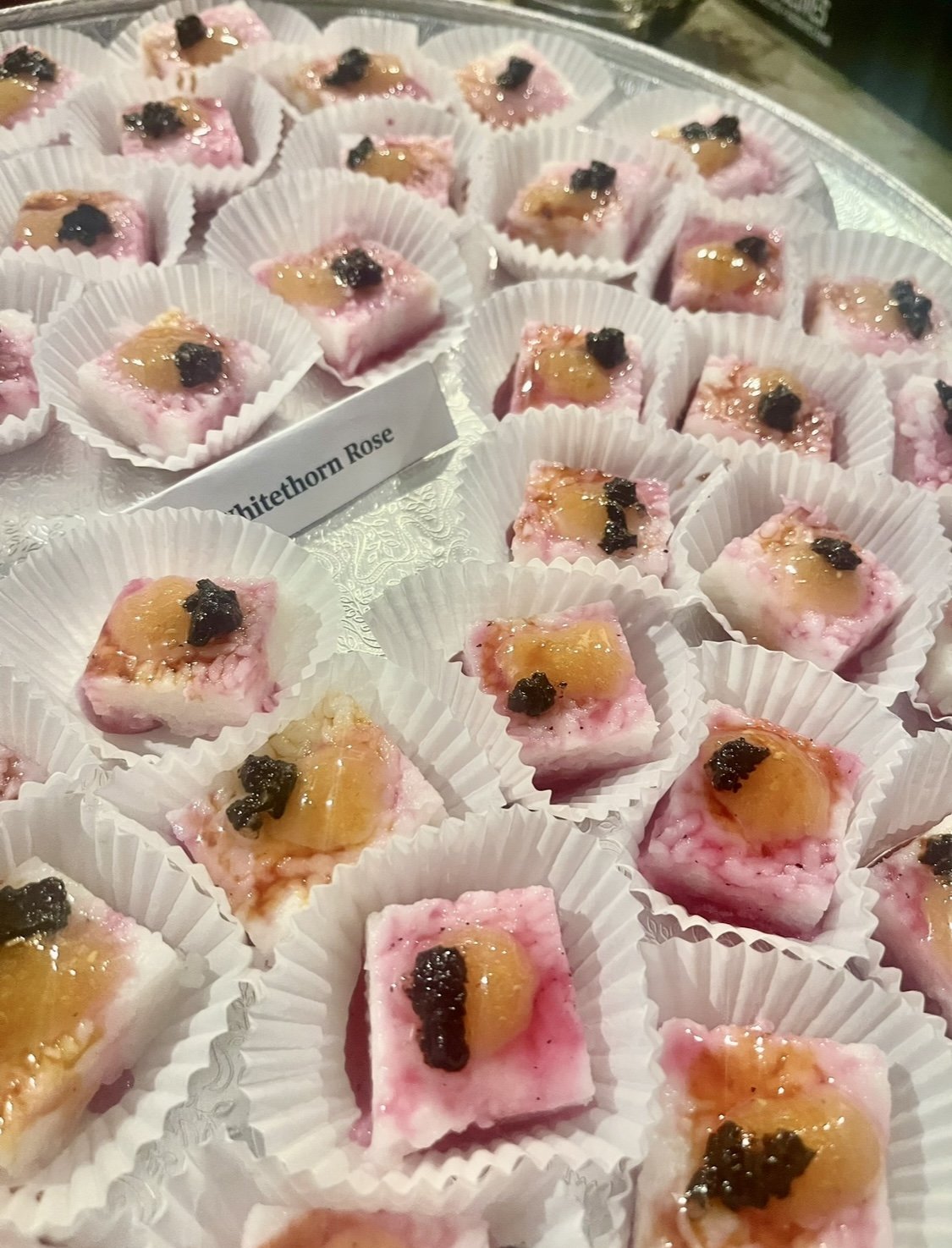High Tea Humboldt: A Perfectly Curated Hash And Tea Pairing Event
Photos Courtesy of Author
Nick Tanem, world-renowned solventless instructor and educator, first came up with the idea for High Tea at last year’s Ego Clash event.
“I was DJing and toward the end of the set, my friend Erick (of Deep Creek Collective) brought out his Gong Fu Cha tea set and started serving tea as I was playing music. It was a vibe!” Nick said. “One of the first things I noticed was the deep earthy flavors of the aged Puerh tea and how they paired perfectly with the gas and petrichor-tasting hash spliff I was smoking on.”
How High Tea Came to Be
Nick set out to recreate these flavor combinations and “feelings of uplifting yet grounding energy frequencies that developed from that session.” After some collaboration with Deep Creek Collective, he aimed to be intentional about the specific pairings and the history of both hashish and traditional Chinese tea.
Buckminster Barrett started Deep Creek Tea Collective as an extension of Soft Medicine Sanctuary, a tea and elixir house in Sebastopol, California where he is a co-owner. His first customer was Erick Bernardino, and over the next year, the two formed a friendship and a common interest in tea.
For the setting, it seemed only natural to bring this initial experience to the Ganjier campus, where Nick is also a Council member and instructor. Also known as Hokepos meaning “The Garden” in ancient Greek, the campus was formerly a Kung Fu dojo with a tea room and sweat lodge. The main house, event space, and cabins are set in the mountains of Northern California among redwoods and running water on the north and south sides of the 243-acre property.
When Derek Gilman, managing director for The Ganjier program, was searching for a new location to educate their growing community of students, he was drawn to this location for its Fung Shui and Chinese symbolisms of longevity throughout the property. Gilman, a connoisseur and cultivator himself, offered to host the event, and Alex Scherma, the on-site chef of The Ganjier, was brought into the project as the logical choice for creating a menu for the day.
Known for his anti-inflammatory culinary creations and expert terpene pairings, Scherma, also a Certified Ganjier, has been creating menus and keeping students and educators fed over the past 2 years. For this particular menu, he was able to source local ingredients that complemented the flavor profiles of the hash and tea pairings. The rice and local chicken from a nearby farm in Eureka accented the earthy notes of the Pu Erh tea, and his dishes were named in honor of the various hash cultivars tasted during the event.
Several other people brought something to share, which added to the community aspect of the day. Sarah Jain, the Hash Sommelier, provided fresh fruit paired with a live rosin dab bar, with hash from HaveHash and Sought After Solventless. Hookah seshes with the iconic Quasar Shisha Hookah throughout the event were hosted by Lena Burns of CannamGardens. Samples of several different hash cultivars were tasted throughout the all-day event.
Coup D’etat, cultivated by Bandwagon Gardens and processed into Live Temple balls by Nasha Humboldt is known for its earthy and sweet flavors. Nick says he knew it would be best consumed in a 3-hole bowl provided by Cool Hand Suuze. Strabe Glass and Evan Shore
Bangers were used to consume Moroccan Peaches, cultivated by local sungrown farmers Alpenglow Farms and processed by Nasha Humboldt. What stood out from this particular cultivar was its exotic citrus and papaya notes that blended beautifully with the aged white tea provided by Deep Creek alongside its floral notes and lightness on the palate.
How Tea & Hash Collide
Guests were also treated to continuous Gong Fu Cha tea service throughout the event.
In the ritual of Gong Fu Cha, it is important to note the temperature of the water- just like dabs! Once it reaches 212 degrees, you pour this boiling hot water over the leaves and steep for 10-20 seconds and then pour it out, doing an initial rinse to start opening the tea up and smell the aromas wafting from the leaves. This helps you experience the tea as a way to connect to the plant and one’s self. Then you would proceed to do several fast steepings.
A traditional GonFu Cha tea service can be anywhere from 10-30 steepings in one sitting. The music provided by NikkaT allowed for deep conversation, and a meditative state was easy to get into with his excellent vibes!
The similarities between tea and hash are far more numerous than one might know or imagine. With a history rooted in culture, economy, and diversity, both have many common aspects. Just as hash is traditionally from a single cultivar, tea is traditionally one plant - oolong, white, yellow - with thousands of iterations within these categories (just like weed!).
On a historical note, tea has catalyzed revolutions, been used as leverage in colonial powers, and yet it is just a leaf. Sound familiar? If you look at the history of cannabis, there are similar nuances. Just as cannabis has the ability to bring people together, tea has also shown its power to melt barriers between social classes and different cultures throughout history.
The various constituents of tea have numerous health benefits. L-theanine, for example, makes people calm in a way that coffee doesn’t. It is a vasodilator, it relaxes the nervous system, has cancer prevention benefits, and much more. This is very similar to the vast number of cannabinoids in cannabis and their ability to be consumed as a full spectrum product, often working best as a “whole plant”. Pu Erh is like the fine-aged wine of teas. You can’t age just any tea - it has to be a certain kind. It ferments and grows beneficial microorganisms. Buckminster notes that his intestinal issues cleared up once he started drinking Pu Erh tea specifically, and many friends have experienced weight loss, balanced emotions more easily, and more.
This form of tea practice has started becoming more popular within the past 20-30 years. A good majority of tea that the world has access to is essentially “shake”. There isn’t a market for it outside of China, however, that is starting to change. Deep Creek sources tea from the Yunnan Province of Southwestern China, an incredibly biodiverse region of China - with mountains, jungles, and borders along Tibet, and Burma, this is the home of the tea forests. Tea cakes are made of aged white tea leaves, which provide nuggets of concentrated microbial activity.
There is something to be appreciated about the numerous ways that tea complements hash and vice versa. The earthy flavors pair well together, and the naturally caffeinated tea brings back focus after the typically stoney feeling produced by consuming hash. The rituals of each are so nuanced, it encourages one to slow down and enjoy the process. A lesson I think we could all stand to practice more.
I would encourage anyone who loves hash to consider adding tea service to your ritual of consumption. Not only does it please the palate and stir the senses, but it is a fantastic way to reflect on oneself and create a space for meditation.
I was stoked to get some goodies from these sponsors as well!
Nick says that the first annual High Tea Humboldt was a success and they plan to not only do this event yearly but also hope to take High Tea on the road to other international destinations in the future as well. If you are interested in bringing the High Tea experience to your event, please reach out to Nick Tanem directly through his website.
To experience the energy at Hokepos is a vibe all its own - to book your own experience or event, please visit https://hokepos.com




